Birdfinding.info ⇒ A critically endangered avian oddity that is rapidly disappearing. Its Siberian breeding grounds are remote and most of its known wintering areas are not easily accessible. In recent years, however, it has been found regularly from late October to early April in salt pans southwest of Bangkok, Thailand (especially Khok Kham and Pak Tha Le). In spring and fall it occurs regularly at several sites along coasts of the Yellow Sea, including Jianggang and Yangkou, north of Shanghai.
Spoon-billed Sandpiper
Calidris pygmaea
Breeds in eastern Siberia. Winters along coasts of southern and eastern Asia.
Breeding. Breeds from late May into July on coastal tundra of Chukokta and Koryakia, where its preferred habitat is “lagoon spits with crowberry-lichen vegetation or dwarf birch and willow sedges, together with adjacent estuary or mudflat habitats that are used as feeding sites by adults during nesting.” (BirdLife International 2018)
A 2016 estimate of the total breeding population was approximately 120 breeding pairs, down from approximately 2,000 pairs estimated in the 1980s.
Nonbreeding. In winter, it occurs locally at a few widely spaced coastal locations that extend from eastern India and southeastern China south to Singapore, always on or near extensive mudflats. In some areas, it divides its time between salt pans and adjacent mudflats.

Spoon-billed Sandpiper on its breeding grounds. © Jan van de Kam
Surveys indicate that approximately half of the global population winters in Myanmar’s Bay of Martaban. Smaller concentrations winter on the Ganges River Delta and nearby coasts of Bangladesh, the upper Gulf of Siam in Thailand, the Mekong Delta in Vietnam, and Leizhou Bay in Guangdong, China.
Much smaller numbers, or scattered individuals, sometimes appear in winter nearly anywhere along the coasts of eastern and southern Asia, including the full length of the Malay Peninsula, west to southern India and Sri Lanka, and northeast to Taiwan.
Movements. Migrates north in April and May, when much of the population apparently convenes along the coasts of the Yellow Sea: in particular the coast of Jiangsu, China, and the Saemangeum, Nakdong, and Geum estuaries, and Gomso Bay in South Korea.
Southbound migration begins in July and lasts well into October. Again, most of the population congregates at serval bays and estuaries around the Yellow Sea.
Individual migrants or small groups appear sporadically at coastal locations nearly throughout eastern Asia, including Japan, Taiwan, and the entire Chinese coast.
Vagrants have been recorded in Alaska several times during June and July: on the outer Aleutians, Pribilofs, and northwestern coast. There is also a single record from southwestern British Columbia (Iona Island, July 30 – August 2, 1978).
Identification
Unmistakable: a small sandpiper that is immediately recognizable by its unique spatulate bill. Otherwise, Spoon-billed is very similar to several other small sandpipers, especially the Red-necked Stint, which occurs throughout its range.
Basic plumage is white below and mottled pale gray-brown above.
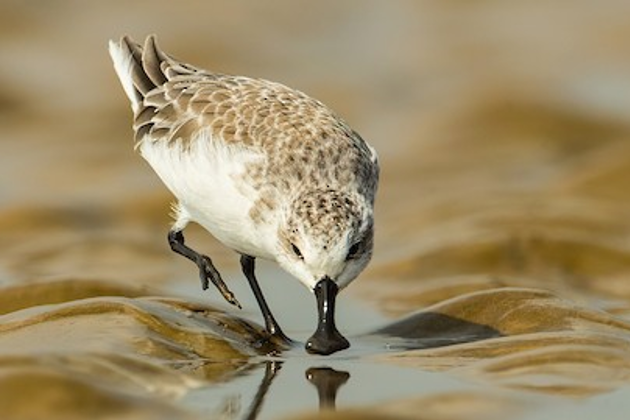
Spoon-billed Sandpiper, basic plumage. (Jianggang, Jiangsu, China; October 3, 2019.) © Lefei Han

Spoon-billed Sandpiper, basic plumage, giving an excellent view of the structure of its bill. (Jiangsu, China; October 23, 2013.) © Baz Scampion

Spoon-billed Sandpiper, basic plumage. (Pak Tha Le, Phetchaburi, Thailand; January 4, 2018.) © Peter Ericsson

Spoon-billed Sandpiper, basic plumage. (Yangkou, Jiangsu, China; October.) © Craig Brelsford

Spoon-billed Sandpiper, basic plumage with fading traces of alternate plumage. (Jiangsu, China; October 23, 2013.) © Baz Scampion

Spoon-billed Sandpiper, alternate plumage. (Meinypilgyno, Chukotka, Russia; June 2011.) © Gerrit Vyn
In breeding plumage, the head, neck, chest, and back are infused with orange-rust, the scapulars have large black centers, and dark-brown spots and chevrons appear on the breast and flanks.

Spoon-billed Sandpiper, molting into alternate plumage. (Mai Po Nature Reserve, Hong Kong; April 21, 2018.) © Lo Chun Fai

Spoon-billed Sandpiper, alternate plumage. (Chukotka, Russia; July 10, 2012.) © Baz Scampion

Spoon-billed Sandpiper, alternate plumage. (Simpo, South Korea; April 2008.) © Richard Chandler
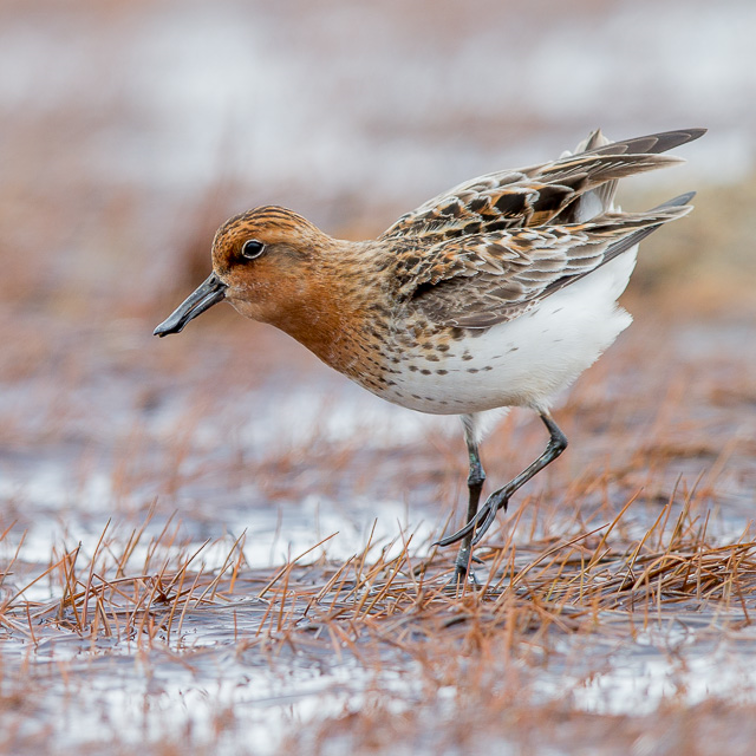
Spoon-billed Sandpiper, alternate plumage. (Chukotka, Russia; June 14, 2014.) © Jacques Cloutier

Spoon-billed Sandpiper, alternate plumage. (Meinypilgyno, Chukotka, Russia; June 2011.) © Gerrit Vyn
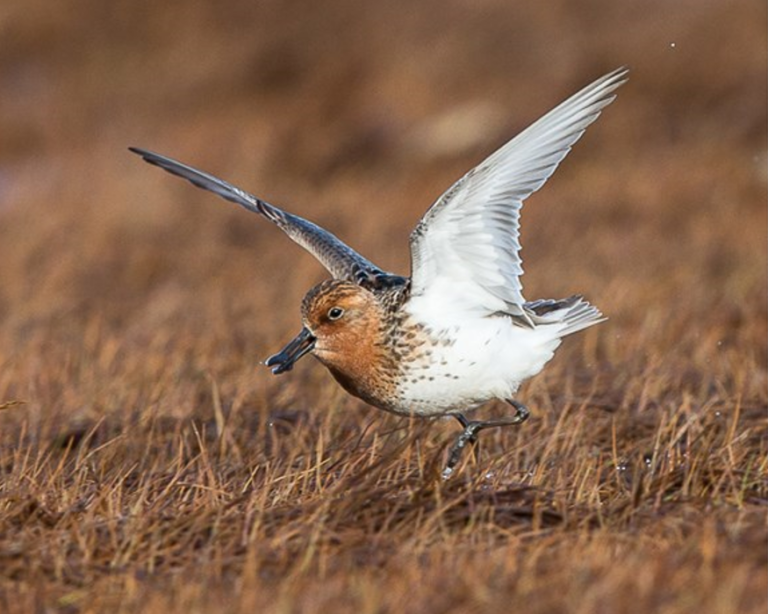
Spoon-billed Sandpiper, alternate plumage, showing white underwings. (Chukotka, Russia; June 14, 2014.) © Jacques Cloutier

Spoon-billed Sandpiper, alternate plumage. (Meinypilgyno, Chukotka, Russia; June 2011.) © Gerrit Vyn

Spoon-billed Sandpiper, in display flight, ventral view showing white underparts. (Chukotka, Russia; June 1, 2012.) © Baz Scampion

Spoon-billed Sandpiper, juvenile. © Kim Tae-Young
Juvenile and first-winter plumages resemble the basic plumage, but with stronger contrast between dark feather centers and bright fringes on upperparts. Also typically show a noticeably darker crown than basic plumage.
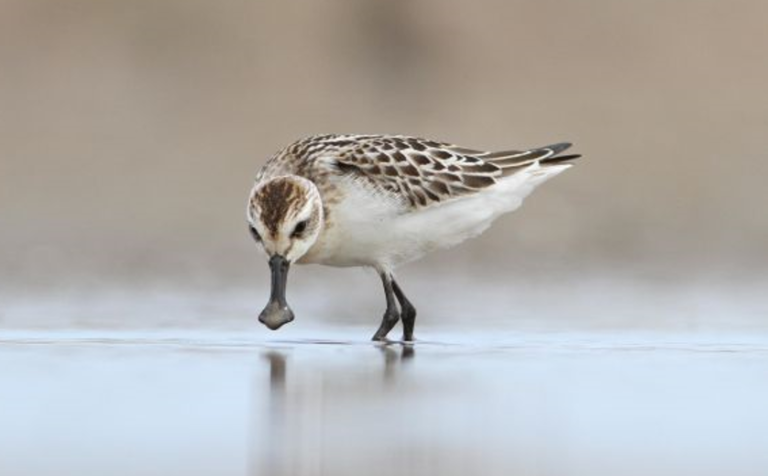
Spoon-billed Sandpiper, juvenile. © Chen Tengyi
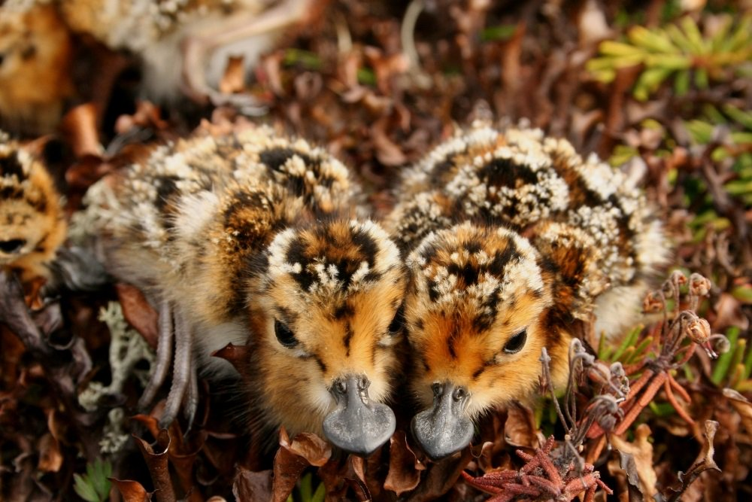
Spoon-billed Sandpiper, chicks hatch with spoon-shaped bills already formed. © Pavel Tomkovich
Notes
Monotypic species.
IUCN Red List Status: Critically Endangered.
References
BirdLife International. 2018. Calidris pygmaea. The IUCN Red List of Threatened Species 2018: e.T22693452A134202771. https://dx.doi.org/10.2305/IUCN.UK.2018-2.RLTS.T22693452A134202771.en. (Accessed February 6, 2020.)
Brazil, M. 2009. Birds of East Asia. Princeton University Press, Princeton, N.J.
eBird. 2020. eBird: An online database of bird distribution and abundance. Cornell Lab of Ornithology, Ithaca, N.Y. http://www.ebird.org. (Accessed February 5, 2020.)
Hayman, P., J. Marchant, and T. Prater. 2009. Shorebirds: An Identification Guide. Houghton Mifflin, Boston.
Van Gils, J., P. Wiersma, C.J. Sharpe, and G.M. & Kirwan. 2020. Spoon-billed Sandpiper (Calidris pygmaea). In Handbook of the Birds of the World Alive (J. del Hoyo, A. Elliott, J. Sargatal, D.A. Christie, and E. de Juana, eds.). Lynx Edicions, Barcelona. https://www.hbw.com/node/53939. (Accessed February 6, 2020.)
Vyn, G. 2013. Last of their kind: On the tundra with the endangered Spoon-billed Sandpiper. All About Birds. https://www.allaboutbirds.org/news/last-of-their-kind-on-the-tundra-with-the-endangered-spoon-billed-sandpiper/.
